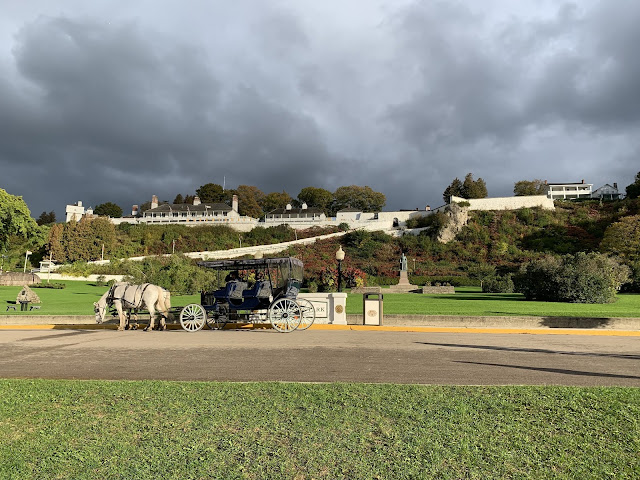 |
| Michael Nassaney delivering his CFCS presentation to a riveted crowd. Photo by Erika Hartley. |
The Center for French Colonial Studies held its annual conference in Mackinaw City, Michigan, Oct. 4-6, 2019. This is an important place for French colonial aficionados because it’s the site of Fort Michilimakinac, the most strategic French trading post in the Great Lakes region. You might say it’s the “mother fort.” Indeed, archaeologists are drawn to it because it has been the site of continuous archaeological investigations since 1959—and they’re not done yet!
To provide some historical context, Jean Nicolet was the first documented French explorer in the Upper Great Lakes region when he passed through the Straits of Mackinac in 1634 in search of that illusive northwest passage to China. Father Jacques Marquette founded his mission at St. Ignace on the north side of the Straits in 1671. Sometime between 1679 and 1683 the French formally established a military presence with the construction of Fort de Buade, also referred to as Missilimakinak (Michilimackinac), in the same area. Lamothe Cadillac served as commandant of the post at the end of the seventeenth century, and the French stayed at the Straits after he departed to establish Fort Pontchartrain in 1701 at present day Detroit. The French moved to the south side of the Straits in 1715 and built Fort Michilimackinac where they officially remained until the end of the Seven Years War, surrendering the fort to the British in 1761.
 |
| A welcoming entrance to a French-style building at Fort Michilimackinac. Photo by Helen Crist. |
Conference participants were treated to a behind the scenes tour of the reconstructed fort by Dr. Lynn Evans, Director of Archaeology for the Mackinac State Historic Parks Commission. In addition to seeing French-style buildings reconstructed precisely where they once stood, we also witnessed a wide array of artifacts from among the more than one million that have been recovered from the fort, along with preserved archaeological remains such as the burned roof timbers of the powder magazine that the British destroyed before moving to Mackinac Island in the late 1770s.
Saturday was filled with presentations about the archaeology (of course!), history, and genealogy of the French in the Mackinac region. Fort St. Joseph staff and supporters were well represented on the program and in the audience. Lynn Evans discussed some of the artifacts of religious devotion from Michilimackinac, a timely topic since Dr. Joe Brandão and I are currently studying the Jesuits and religious artifacts at Fort St. Joseph. James Dunnigan, a participant in the 2013 field season at Fort St. Joseph and M.A. candidate in Anthropology at WMU, discussed his research on the external village at Fort Michilimackinac. I had the opportunity to summarize 21 years of investigations at Fort St. Joseph, drawing on findings from our recent book, Fort St. Joseph Revealed (University Press of Florida, 2019). I closed by sharing some of the exciting work we conducted this past field season that revealed in tact deposits associated with the fort beneath the 20th century dump that deterred archaeologists for decades. Erika Hartley, the current Fort St. Joseph Curatorial Fellow, discussed the work we are doing to preserve the past for the future at Fort St. Joseph and why it is important to ensure proper curation of the archaeological collection.
 |
| The colorful Timothy Kent addressing the audience at the conference. Photo by Loraine DiCerbo. |
After lunch, our friends and supporters from the French-Canadian Heritage Society of Michigan discussed what they have learned about their ancestors, including some people who lived at Fort St. Joseph and traveled throughout New France. The last two papers shed light on the Native peoples of the region, how they interacted with Catholics priests, and how they are currently reviving their language. The day ended with an authentic Native American feast followed by an informal yet informative presentation by Timothy Kent. It’s always a pleasure to hear Tim chat about his work drawn from (in his words) “original French documents, archaeological site reports, museum collections, genealogical research on more than 800 of my direct French and French Canadian ancestors, visiting and studying at each of the 137 ancestral communities in France, several decades of private living history research (focusing on the lives of a French trader of the seventeenth century and his native family), and paddling with my wife and two sons from end to end the 3,000 mile length of the mainline fur trade canoe route across the U.S. and Canada.” Tim visited Fort St. Joseph as a public scholar in 2011 when our focus was the fur trade and he hasn’t missed a beat in his knowledge and enthusiasm.
 |
| Fort Mackinac from a distance with menacing storm clouds rolling in. Photo by Erika Hartley. |
After an exhilarating weekend, some of us still had the energy to brave wind and high seas to take the ferry to Mackinac Island to conquer yet another fort. The following morning before an early breakfast I ran into the intrepid travelers: Erika Hartley, Mary Ellen Drolet, Neal and Kathy Hassinger, and Lynn and Meryl Christensen. I’m sure Fort Mackinac and its personnel were able to withstand any affront these French sympathizers from Fort St. Joseph tried to wield.
Until next time, Michael Nassaney